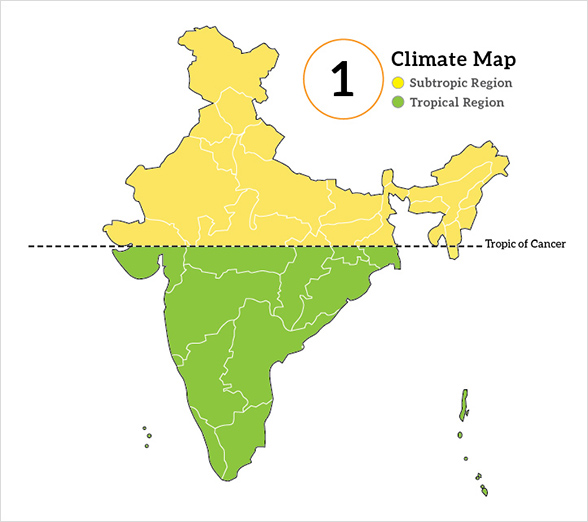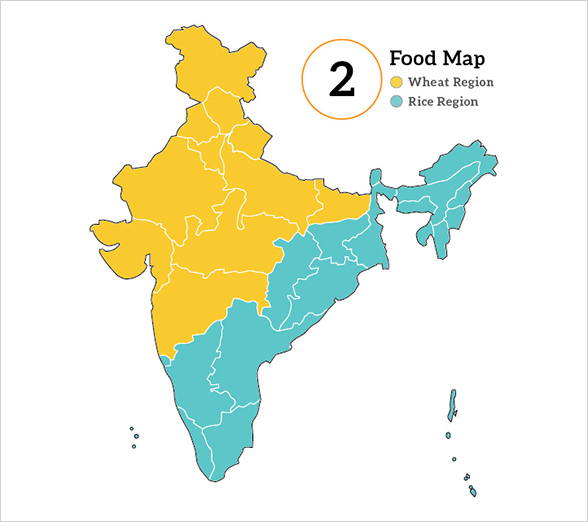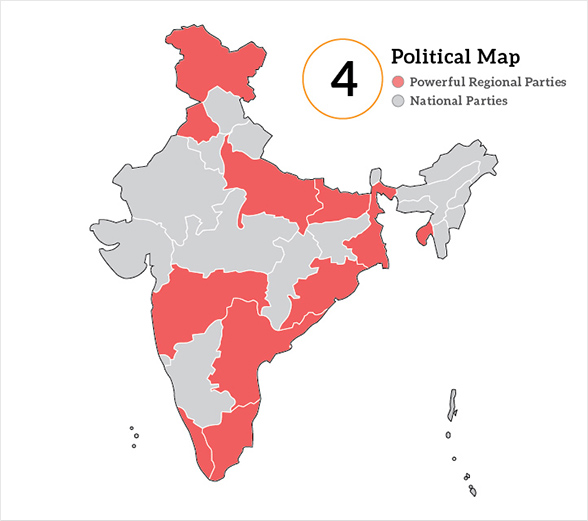Punjabi Bhangra, Dilli chaat, Kashi yatra, Dargah qawwali, Kashmiri carpet, Rabindra sangeet, Darjeeling tea, Coorg coffee, Assam bihu, Kerala coconut, Carnatic classical music, Hyderabadi Biriyani, Lucknavi lehengas, Goan feni, Gujju dhoklas, Bikaneri Bhujia…
Is there a unifying thread in the diversity of Indian culture? Or is it just an amalgamation of various regional cultures stitched together…
Enough has been said about the “unity in diversity” of Indian culture, but often we see divisive issues cropping up that tear apart the delicate fabric of our society. While diversity is the essence of our Indian culture, many of us are unaware of the differences that actually unite various regions of the country. Here are some of the major dividing yet uniting socio-economic and cultural differences of Indian states, as depicted in our colourful infographic:
Climatic regions
Being a large country, India is bound to have wide variations in climatic conditions. The most noticeable variation can be seen on either sides of the Tropic of Cancer, which runs from Gujarat in the west to Mizoram in the east. This latitudinal line forms the boundary between the Tropics and Subtropics. The tropical region below it is characterised by moderate variation in temperature throughout the year, and heavy rainfall. The onset of seasons is one month earlier than the northern Subtropics, which means summer arrives in March.
The northern Subtropics are characterised by drastic variation in temperature and lesser rainfall. Average temperatures can range from 00 C in winter to 400 C in summer. Winters are cold and are characterised by heavy fog. The Vindhya mountain range forms a natural barrier between the two regions. Further, the crops grown in these regions also differ.
Food crop regions
The staple food of Indians is wheat… no, it’s rice… no, it is maize! Can’t say for sure? Yes, our country’s diversity is clearly is visible in the myriad range of food delicacies we eat. So it’s tough to zero in one staple food for entire India. Some of the major food crops are: rice, wheat, millets, roots and tubers. Despite the diversity, the country can be divided mainly into rice eating and wheat eating regions.
Rice is mainly grown and eaten in South and East India, while wheat is predominantly grown and eaten in North and West India. Millets are the preferred staple in tribal areas of Chhattisgarh, Jharkhand, Andhra Pradesh, etc. Meanwhile a recent study by a researcher from University of Virginia has found significant cultural differences between wheat- and rice-growing cultures in India and across the world! Read more about that in this Live Mint report.
Language segmentation

Now we come the more controversial topic, which is highly divisive in India. Languages have played a major role in building the cultural identity of different states. In fact, Indian states were reorganised on a linguistic basis just after the independence, forming many new states and cutting down many existing ones. While many people prefer this federal set up with each state carving its own identity, people who prefer a centralised set-up feel this is the reason why India does not present a unified front.
We have segregated the country into Hindi heartland and all states with regional languages. So there are 9 Hindi speaking states and 19 states with different regional scheduled languages such as Marathi, Punjabi, Tamil, etc. This map indicates that it would take a long time before Hindi can officially become a pan-Indian language. Till then, our beloved British imposition will have to serve as the subsidiary official language!
Political parties
The political map of India has undergone a drastic change in the 2014 general elections. For the first time in 30 years, a single party has emerged with a clear majority, brushing aside the rising power of regional political parties. Over the last two decades, regional political parties have been building enough strength to ensure that national parties dance to their tune in coalition governments. In fact, the rising power of regional parties indicated that India is heading more towards a federal decentralised set up.
There are states that have well established presence of national parties such as INC and BJP; then there are states such as Uttar Pradesh, Tamil Nadu, etc., where regional parties hold sway. Some of these regional parties are built on ideological platform such as CPI, CPI-M, BSP, etc., while most of them are established to cater to regional aspirations – Telangana Rashtra Samithi, Peoples Democratic Party, etc.
Religion
Here comes the most contentious issue that is more divisive than anything else. Religion has always played a major role in the Indian society since times immemorial. While many of us blame our erstwhile rulers for their “divide and rule” policy, we don’t realise that we as a society were never united or were waiting to be divided!
Our religion map shows some of the states as non-Hindu, when they are in fact Hindu majority regions. That differentiation is actually to show that a significant non-Hindu minority live in these states. For example, West Bengal has 25% Muslim population, while Kerala has 24%. Similarly, Goa has 26% Christians, while Mizoram has 87% Christians. Gujarat and Rajasthan have significant minority of Jains 2% and Parsis (Zoroastrianism) comprising just 0.006%. Punjab and Kashmir are the two states with non-Hindu majority population. Buddhism is practised in Himachal Pradesh, Arunachal Pradesh and Sikkim.
Culture of Indian States Infographics

Factfile –
http://www.mapsofindia.com
http://www.mapsofindia.com
http://www.livemint.com
http://en.wikipedia.org










Very well written… Found the content very informative and to the point …
Thanks Pooja…
uttarakhand is hindu state not bodha state 98% people hindu are theare.
According to 2011 Census of India figures, 54.73% of Kerala’s population are Hindus, 26.56% are Muslims, 18.38% are Christians, and the remaining 0.33% follow other religions or have no religion. Various tribal people in Kerala have retained the religious beliefs of their ancestors.
According to 2011 Census of India figures, 54.73% of Kerala’s population are Hindus, 26.56% are Muslims, 18.38% are Christians, and the remaining 0.33% follow other religions or have no religion. Various tribal people in Kerala have retained the religious beliefs of their ancestors.
How are Buddhist shown in Uttarakhand as a significant minority? They are 5th largest community in that state and Uttarakhandis are about 80% Hindus and 17% Muslims according to recent surveys and uidai data in 2022.